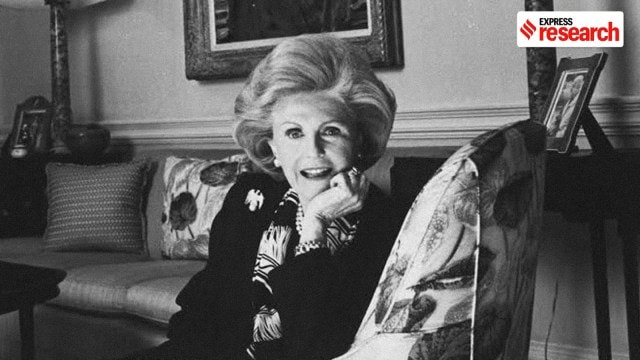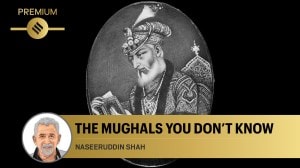Pamela Harriman: The ‘greatest courtesan’ of all time, celebrated for her political diplomacy
A British-born American power broker, Pamela Harriman was known for forging lifelong alliances from what may otherwise have been fleeting affairs.
 Pamela Harriman had relationships with some of the most influential men of her time (IMDB)
Pamela Harriman had relationships with some of the most influential men of her time (IMDB)In an era when titans of diplomacy and debonair seduction reigned supreme, Pamela Harriman remains an icon — a British-born American power broker whose life read like a masterclass in reinvention and intrigue. It was not merely her string of glittering liaisons or her uncanny ability to transform scandal into political capital that is fascinating but also her knack for forging lifelong alliances from what might otherwise have been fleeting affairs.
As British writer Sonia Purnell writes in her book Kingmaker: Pamela Harriman’s Astonishing Life of Power, Seduction, and Intrigue (2024), Pamela was “the greatest courtesan in the 20th century,” blending charm, sex appeal, and geopolitical savvy into a force that shaped transatlantic power dynamics.
An aristocratic start
Pamela Digby was born in 1920 into the fading splendour of Britain’s aristocracy on the family estate of Minterne in Dorset. Her lineage carried a whiff of notoriety: her great-great aunt Jane Digby was a 19th-century adventurer whose “exotic travels and scandalous personal life” included marriages and affairs with kings, princes, and a Bedouin sheikh. This legacy, Purnell suggests, may have whispered a destiny into Pamela’s ear.
Her early years were less illustrious. After begging to leave Minterne, she spent fewer than two years at a Hertfordshire boarding school, emerging with a domestic science certificate as her only formal credential. Then came her debut, meant to pair her with a suitable husband. It was a bust. Though Kathleen Harriman, daughter of Pamela’s final husband, once called her “one of the wisest young girls I’ve ever met…knows everything political and otherwise”, most women thought her ordinary at best.
In 1939, at 19 years of age, Pamela found her ticket to the big leagues: Randolph Churchill, Winston Churchill’s only son. He was no prize; deep in debt, prone to gambling, and a heavy drinker. His proposal to Pamela was more transactional than romantic: he told her she looked healthy enough to bear his child. Undeterred, Pamela said yes.
The Churchills
With war looming, Pamela’s magnetism became a political asset. While Randolph served in the military, she charmed Winston and Clementine Churchill, who recognised her “power over older men through a rare cocktail of flattering attention, smouldering sex appeal, and an impressive grasp of geopolitics,” according to Purell.
During the Blitz in World War II when Germany conducted air raids on London and other British cities, Pamela shared a bunk bed with Winston, later joking that she had “one Churchill on top of me and one inside me”, Purell writes.
Winston also valued her political acumen, discussing war-time politics with her, including her in meetings, and introducing her to high-ranking ministers. Later, she would say, “Nobody ever had a chance to see politics as much from the inside as I did.”
World War II proved her testing ground. She helped the Churchills woo America into the fight, becoming close to President Franklin Delano Roosevelt’s two most important representatives in London – Harry Hopkins and, later, W Averell Harriman, ambassador to Britain at the time America decided to help finance their ally in the war.
Pamela’s flat in Grosvenor Square – dubbed ‘Eisenhowerplatz’ – hosted influential Americans, and she gleaned high-level intelligence from her lovers and friends, passing it along to Winston, and as some allege, vice versa. At 23, she was already a linchpin of the Anglo-American alliance.
Post-war Paris and Hollywood hustle
After the war, Pamela left Randolph and moved to Paris, embarking on high-profile affairs with Prince Aly Khan, son of the third Aga Khan, then with Gianni Agnelli of the Fiat empire, and later Baron Elie de Rothschild, the French banking magnate. Each liaison brought her deeper into Europe’s elite circles.
By 1960, she had met Hollywood producer Leland Hayward and their marriage scandalised Los Angeles. She entered a world of premieres and private jets, but Hayward’s children, especially daughter Brooke, resented her, accusing her of pilfering heirlooms and sidelining the family.
Hayward’s death from a stroke in 1971 left Pamela a widow at 51 but she was not one to linger in grief. Within months, she rekindled a flame from her wartime past: W Averell Harriman, the American diplomat and railroad heir she had met in London 30 years ago.
The Harriman encore
Harriman, now 79 and mourning the loss of his second wife, Marie, was vulnerable, and rich. “She was pushing at an open door,” Purnell writes, as he too was interested in reacquainting with her. Six months after Hayward’s death, they married in a private ceremony, a union that raised eyebrows for its speed and the stark 28-year age gap.
Pamela’s charm, undimmed by time, captivated Harriman anew. “He was almost certainly the love of her life,” Purnell posits, though her affection was inseparable from ambition. Harriman’s $ 115 million fortune, amassed from railroads, banking, and real estate, offered her a canvas for reinvention.
They settled into his Georgetown mansion, its walls lined with Marie’s art collection, including a van Gogh and a Picasso, and purchased Willow Oaks, a sprawling estate in Virginia’s hunt country.
Pamela transformed these spaces into political salons, their grandeur evoking a bygone era of American wartime power. Guests savoured turtle soup and Chateau Margaux, while Pamela, adorned in couture and pearls, regally presided.
In Washington, she became a linchpin of the Democratic Party. She launched PamPac, a political action committee that channelled funds to Congressional hopefuls, amassing a stellar record in backing the right candidate.
Her Georgetown dinners were legendary; candlelit affairs where senators, journalists, and foreign dignitaries debated policy over three courses. “She helped buoy Democrats during the glum Reagan years,” Purnell writes, “injecting glamour and pizzazz with her parties, and gritty Churchillian optimism with her reassurances that they could regain the White House”.
Theodore Sorensen, former US president John F Kennedy’s speechwriter, marvelled, “Among people who matter, people who think…she is considered a great woman who has made a distinguished life.”
Harriman’s death in 1986 ignited another firestorm. His children from his first marriage, furious at Pamela’s inheritance of his $115 million estate, accused her of manipulating their ageing father. “She turned him against us,” one daughter claimed, noting how Pamela controlled access in his final years. The legal battles that followed—over trusts, artworks, and even Willow Oaks—were bitter and public, with headlines painting Pamela as a scheming widow. Yet she held firm, her composure unshaken. “I earned every penny,” she told a friend, “by keeping him happy and alive”.
Pamela’s influence reached its zenith in the 1990s. She spotted promise in a young Arkansas governor, Bill Clinton, hosting him at Willow Oaks and later pairing him with Al Gore for the 1992 ticket. “She saw in Slick Willie a reflection of her own ambition,” a confidante recalled in Kingmaker. Her home became a proving ground for Democratic hopefuls, its guestbook a who’s-who of the party’s future: Joe Biden, John Kerry, even a young Barack Obama in his pre-Senate days.
Ambassadorial coda
In 1993, the US president Bill Clinton repaid Pamela’s early loyalty with the plum post of ambassador to France. At 73, she returned to Paris not as a courtesan but as a stateswoman, her appointment a capstone to a life of influence. The French, far from recoiling at her scandalous past, embraced her with open arms. “Her woman-with-a-past status did nothing but enhance her standing,” Purnell observes. Her residence at 33 Rue du Faubourg Saint-Honoré became a hub of diplomacy, its salons echoing with the clink of champagne flutes and the murmur of high-stakes conversation.
Pamela was no figurehead. She arrived with a Rolodex spanning continents and a knack for turning charm into leverage. During the Bosnian War, she played a pivotal role in supporting American diplomat Richard Holbrooke’s peace negotiations. “She made herself the most successful American political ambassador of the decade,” wrote journalist William Pfaff in the International Herald Tribune.
Holbrooke himself praised her, recalling how she hosted critical meetings with Balkan leaders, her elegance disarming even the most hardened negotiators. “She knew everyone, and everyone wanted to know her,” he said. Her fluency in French—honed during her postwar years—and her ease with the Parisian elite made her a formidable envoy.
She navigated transatlantic friction with aplomb. When the US and France clashed over trade or NATO, Pamela smoothed ruffled feathers with private dinners and well-timed flattery.
Then French President Jacques Chirac, upon her death, called her “a peerless diplomat” whose “grace and intelligence bridged our nations”. She hosted luminaries from both sides of the Atlantic including Nelson Mandela, Mikhail Gorbachev, and even Princess Diana. “She could talk arms deals with a general and fashion with a couturier in the same breath,” a staffer recalled according to Purell.
Her tenure was not without strain. Critics in Washington grumbled about her age and lack of formal credentials, but Pamela silenced them with results. She championed cultural exchanges, oversaw embassy renovations, and even weathered a minor scandal when a French tabloid revived tales of her youthful affairs. She laughed it off, telling an aide, “If they’re still talking about me, I must be doing something right.”
Her life ended abruptly in 1997 when she suffered a cerebral haemorrhage while swimming at the Ritz’s pool, a fittingly glamorous exit. Chirac attended her funeral, joined by Clinton and a host of dignitaries, their presence a final bow to a woman who had turned soft power into an art form.
The backlash
Pamela’s rise drew scorn, often tinged with sexism. In 1993, US Senator Strom Thurmond called her “the Whore of Babylon” during her ambassadorial confirmation hearing. Critics derided her for climbing via marriages, and both Leland Hayward’s and Averell Harriman’s children accused her of manipulation and gold-digging. Yet even detractors admitted her political heft. She played a key role in US-UK relations during WW-II, buoyed Democrats during the Reagan era, and made her mark on international diplomacy in Paris.
Her legacy remains complex—she was both celebrated and vilified. But Pamela Harriman, whether courtesan or kingmaker, left behind a story that resists easy judgment, a testament to a woman who played by her own rules and, more often than not, won.
References
Kingmaker: Pamela Harriman’s Astonishing Life of Power, Seduction, and Intrigue, Sonia Purell, Random House 2024
Must Read
Buzzing Now
Apr 01: Latest News
- 01
- 02
- 03
- 04
- 05

























